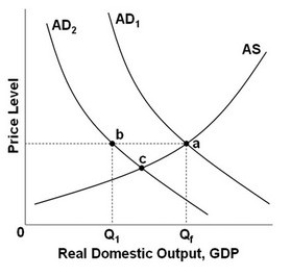Multiple Choice
 Refer to the above graph. The ratchet effect would suggest that:
Refer to the above graph. The ratchet effect would suggest that:
A) if AD1 moves to AD2, the new equilibrium would be at b.
B) if AD1 moves to AD2, the new equilibrium would be at c.
C) if AD2 moves to AD1, the new equilibrium would be at a.
D) if AD2 moves to AD1, the new equilibrium would be at b.
Correct Answer:

Verified
Correct Answer:
Verified
Q24: A rightward shift of the aggregate demand
Q25: The following list contains items that are
Q26: <img src="https://d2lvgg3v3hfg70.cloudfront.net/TB9951/.jpg" alt=" - Refer to
Q27: When there is an increase in aggregate
Q28: <img src="https://d2lvgg3v3hfg70.cloudfront.net/TB9951/.jpg" alt=" - Refer to
Q30: A change in household indebtedness will cause
Q31: If the U.S. dollar appreciates in value
Q32: The following list contains factors that are
Q33: When the price level falls:<br>A) the demand
Q34: A decrease in aggregate demand is likely